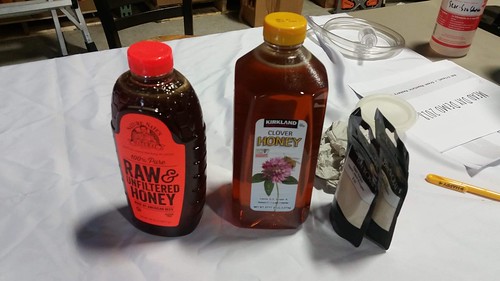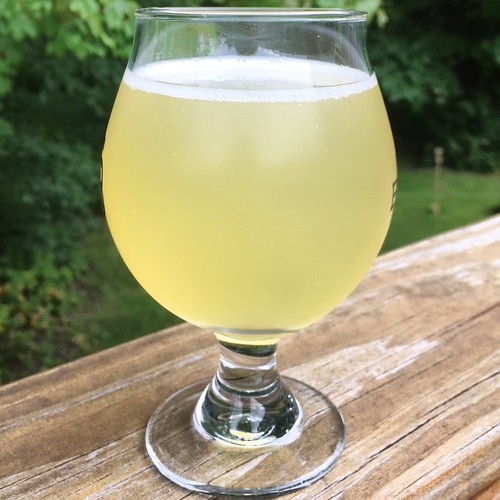Homebrew #69: A Mead Has No Name (2018 Mead Day Mead)
¶ by Rob FrieselLike I said last year: “How do I get myself into these things?” Except… now I know how I get myself into these. As a back-to-back Vermont Mead Maker of the Year, I feel like it’s my responsibility to get out there and demo the art for people.
In the year 2018, the Mead Day demo mead becomes A Mead Has No Name:
There’s no real inspiration here. The AHA’s Mead Day was coming up and I’d already volunteered (more/less a year in advance) to give the demo. Pile onto that my connection with Groennfell and… of course I was going to do this again.
The main theme, at least for me, with this year’s demo was going to be: How can I make this look easy and inexpensive? I wanted to make mead look like anyone could do it because anyone could afford it.
Brew Day
I started the demo with a short presentation (vide infra) on mead and mead making. ^^It was a variation on the presentation I gave at the 2017 Vermont Code Camp.^^^ A little history, a little bit about the styles, the ingredients, and the process. Really though, we were there to learn about the process.
I showed off the honey. “You can get this stuff at CostCo.”
I talked through the yeast nutrient and the yeast. I talked through the sanitizing and the Campden tablets. ^^To be fair, I had a great question about the Campden tablets that I couldn’t answer. “Why do they kill the wild yeast and stuff but not the stuff that you pitch later?” I’d never really thought about this. I’ve looked into it, but I’m still not totally sure that I understand it beyond “but just not those yeast.”^^^
The demo itself took… about 30 minutes. Maybe fewer. There’s some mixing of honey and water. You add the nutrients and the Campden tablets. And… that’s pretty much it.
From there, Ricky the Meadmaker chimed in as co-host. He spoke to the differences between making mead at the homebrew and commercial scales. He talked about how oxidation doesn’t affect mead the same way that it affects beer (and had quite the sample to share with us). He gave us all a behind-the-scenes tour (complete with off-the-tank mead samples) that was enlightening and fun.
And to top off the afternoon, we did a nice big Mead Day toast.
Fermentation
The must was 1.056 when I pitched the next afternoon. I’d targeted 1.061, but I also put an extra half-gallon of water into the fermentor. So there’s that. Rehydrated 10 g of D-47 with 12 g of Go-Ferm and… pretty much walked away from it for a couple weeks.
I noticed some activity in the airlock on the next day, but it was six days before I even looked at the bucket again. I took a gravity reading to find it had come down to 1.001. And then it was another two weeks before I peeked again. It finished at 0.998, which is typical for my meads. I kegged it the next day and put it on CO₂ for about a week.
Overall Impressions
It’s totally serviceable and more/less exactly what I was going for from an inexpensive and low-effort mead. Not amazing, but 100% drinkable.
AROMA. Low overall aromas. Some mild notes that hint at raw honey, and background floral aspect. Fermentation character seems clean and implies elements like white wine.
APPEARANCE. Pale yellow. A slight haze. (One of those “New England Meads”?) Short fizzy white cap when it’s first poured. Lots of medium-sized fast-rising bubbles.
FLAVOR. Even-keeled and restrained. Some up-front honey character, though not particularly sweet. An odd (but low) flavor in the mid-palate that’s almost soapy ^^Ugh. Soapy isn’t even the right word but it’s the closest one I can think of.^^^; distracting but not exactly unpleasant. A retronasal floral character. Finish implies a underripe oranges or tangerines. Very dry.
MOUTHFEEL. Light bodied. Smooth. Dry. A little bit of alcohol warming, but nothing over-the-top.
OVERALL IMPRESSION. I’m getting better at this, but far from a master. All things considered, I would say I made a good (certainly drinkable) mead from inexpensive ingredients, and after all: isn’t that the point of the Mead Day demonstration? It’s a good-enough mead that anyone can make it with almost no effort and easy-to-come-by ingredients. And in that way, it’s a launch pad.
Perhaps this will be my go-to recipe for future demos.
Recipe
The recipe for A Mead Has No Name is as follows:
Water Chemistry
Starting with the Champlain Water District profile as a base… add 1 Campden tablet per gallon.
Fermentables
- 5 lb. Kirkland clover honey (“the cheap junk stuff”)
- 3 lb. wildflower honey (“the orange label stuff at CostCo”)
Yeast
Lalvin D-47 (2 × 5 g sachets, rehydrated with 1.2 g/g Go-Ferm)
Brew Day
- Collect 20 qt. water and heat to 105°F.
- Run off 3 gal. water into the mixing bucket. Add 8 lb. of honey and mix thoroughly. You now have must.
- Add 4 oz. yeast nutrient to the must and mix thoroughly.
- Add 5 crushed Campden tablets to the must and mix thoroughly.
- Run off must into fermenting vessel and top off to 5 gallons.
- Let sit 24 hours for Campden tablets to finish working.
- Aerate the must; pitch D-47 yeast.
- Start fermentation at 70°F.
Beyond Brew Day
- Allow fermentation to complete (approx. 2-3 weeks) at approx. 70°F.
- When fermentation completes, go ahead and package. Maybe cellar some to see how they age. Otherwise…
- Enjoy!
Details
A Mead Has No Name, a dry mead by Tilde Gravitywerks
| Original Gravity | 1.056 |
| Final Gravity | 0.998 |
| ABV | 7.7% |
| Attenuation | 103.8% |
| Links | Flickr |




Leave a Reply